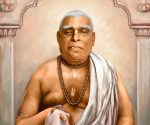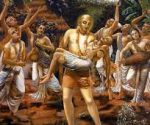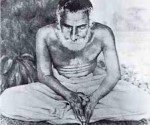If Humility Alone Breeds Devotion, Then Santa Clause Exists!
May 15, 2013 (VNN) by Radhakrsnadasa Brahmacari (GKG) of ISKCON branch of Sri Gaudiya Vaisnava Sampradaya of the overall Sanatana Vedic Dharma
 (Humility – both external and internal – is not a pivot of the demeanour of a Vaisnava, though it can be one of the significant aspects of the same – if made utilized for Krsna-anusilaman accompanied by anugatya.)
(Humility – both external and internal – is not a pivot of the demeanour of a Vaisnava, though it can be one of the significant aspects of the same – if made utilized for Krsna-anusilaman accompanied by anugatya.)
Prima Facie view – “We think that a mere theoretical knowledge is not the same as realization. Certainly it is useful in the very least. But it is only as useful in the end as it serves to soften one’s heart and thereby help to fuel one’s practice. Humility is part of the fourfold decorum mandated by Mahaprabhu required for attaining prema. So when theoretical knowledge is presented pridefully rather than with humility, it is suspect and may not effectively change others’ hearts, despite it being theoretically correct. After all, in that scenario it has not even served to soften the heart of he or she who has it. ”
Conclusive and balanced stand based on scriptural siddhanta – As to how much the theoretical knowledge of the scriptures (jnanam) is relevant in arousing the practical realization (vijnanam) (of course, that theoretical knowledge should be equipped with an unflinching devotion towards the guru-varga and Krsna as stated in the famous Upanisadi mantra i.e. “yasya deve para bhaktir yatha deve tatha gurau…” etc.) is stated in the following excerpts of CC. If bhakti is not scholarship or if bhakti does not need scholarship or if bhakti’s pre-requisite is not erudition then the following quotes from CC 2.22.62-74 will prove wrong at least in the vision of the adamant contenders and such excerpts are herein reproduced as follows –
CC Madhya 22.62: Śraddhā is confident, firm faith that by rendering transcendental loving service to Krsna one automatically performs all subsidiary activities. Such faith is favorable to the discharge of devotional service.
CC Madhya 22.63: By pouring water on the root of a tree, one automatically satisfies the trunk, branches and twigs. Similarly, by supplying food to the stomach, where it nourishes the life air, one satisfies all the senses. In the same way, by worshiping Krsna and rendering Him service, one automatically satisfies all the demigods.
CC Madhya 22.64: A faithful devotee is a truly eligible candidate for the loving service of the Lord. According to one’s faith, one is classified as a topmost devotee, an intermediate devotee or an inferior devotee.
CC Madhya 22.65: One who is expert in logic, argument and the revealed scriptures and who has firm faith in Krsna is classified as a topmost devotee. He can deliver the whole world.
CC Madhya 22.66: One who is expert in logic and in understanding the revealed scriptures, and who always has firm conviction and deep faith that is not blind, is to be considered a topmost devotee in devotional service.
CC Madhya 22.67: One who is not very expert in argument and logic based on the revealed scriptures but who has firm faith is considered a second-class devotee. He also must be considered most fortunate.
CC Madhya 22.68: He who does not know scriptural argument very well but who has firm faith is called an intermediate or second-class devotee.
CC Madhya 22.69: One whose faith is soft and pliable is called a neophyte, but by gradually following the process he will rise to the platform of a first-class devotee.
CC Madhya 22.70: One whose faith is not very strong, who is just beginning, should be considered a neophyte devotee.
CC Madhya 22.71: A devotee is considered superlative or superior according to his attachment and love. In the Eleventh Canto of Śrīmad-Bhāgavatam, the following symptoms have been given.
CC Madhya 22.72: A person advanced in devotional service sees within everything the soul of souls, the Supreme Personality of Godhead, Śrī Krsna. Consequently he always sees the form of the Supreme Personality of Godhead as the cause of all causes and understands that all things are situated in Him.
CC Madhya 22.73: An intermediate, second-class devotee shows love for the Supreme Personality of Godhead, is friendly to all devotees and is very merciful to neophytes and ignorant people. The intermediate devotee neglects those who are envious of devotional service.
CC Madhya 22.74: A prākrta-bhakta, or materialistic devotee, does not purposefully study the śāstra and try to understand the actual standard of pure devotional service. Consequently he does not show proper respect to advanced devotees. He may, however, follow the regulative principles learned from his spiritual master or from his family who worships the Deity. He is to be considered on the material platform, although he is trying to advance in devotional service. Such a person is a bhakta-prāya [neophyte devotee], or bhaktābhāsa, for he is a little enlightened by Vaisnava philosophy.
Thus ends the quoted excerpt from CC.
But still the contenders will argue based on these quotations of BVT.
“To the Saragrahi Vaishnava, the temple has such thrilling charms which the ordinary rationalist can never understand. We do not mean to say that reason is a foolish principle. On the contrary we do not find better admirers of reason than our humble selves. We hold that man’s superiority amongst all created beings consist in man’s possessing the noble gift of reason.
What we maintain in this, that independent of this noble principle there is another higher gift in man which goes by the name of love. reason helps love to maintain its proper bounds in the spiritual world. love often tends to degrade itself by exercising its functions on objects other than God and converts itself into lust for woman, wine, meat and gold. Here reason advises her to rise higher till she reaches her proper sphere above. Thus we find that the object of reason is to help love and not to create it. Reason may be properly styled as the servant of love and must always be subject to her in all her hopes, aspirations and holy works.
The rationalist on the contrary considers reason as all in all. This is degradation of humanity. The progressive rationalist, on the other hand, believes in the principle of love, but attempts to make her the maid-servant of reason. This is another error. He makes spiritual love sometimes a prisoner in the jails of reason. Love wants to soar on her spiritual wings to a realm where the jailer (reason) cannot go and the latter is sure to tie up her wings for fear lest she goes to an unworthy place. Love utters sounds of a spiritual character peculiar to herself, but reason, having no previous experience of it, mistakes it for a disease and administers medicines for her cure. Thus it is that the natural strength of the queen of our soul is crippled by artificial administrations of the dry principle of reason and she rests in us as if a bird taken in a cage.”
To their citation, our answer is that only after descending onto the platform of bhava-bhakti the theoretical knowledge concerning the fundamentals of sadhana-bhakti and sambandha-tattva-jnana start loosening their grip. But even then, the theories pertaining to rasa-tattva and other such advanced topics cannot be ignored because, bhava-bhakti pre-dates rasa-realization. Even the first illumination of prema-bhakti predates the rasa-realization (refer to BRS for more details). Bhava-bhakti does not become transformed into rasa till it acquires the stage of prema and even prema doesn’t transform into rasa till certain criteria is met (i.e. the annexation of the four constituents of rasa with the sthyai-rati and the pre-requisite necessity for the previous samksaras of prema-bhakti to be made mature enough to be called as rasa). Hence, the theoretical exposition on rasa-tattva can never be ignored till the time one actually acquires the parsada-deha or the status of being an associate of the Lord.
Humility cannot be applied in front of ‘jnana-lava-durvidagdha-lokas’ (refer to Bhakti Sandarbha) who not only want to deliberately not understand the sastric siddhanta, but also want to distort it and when they are stopped in their adventure, they want to and taint and curb the efforts of those who propagate the true siddhanta. If humility is shown to these people, such humility will become the object of mere joke for them. After all, our preceptors like SBSST, Baladeva Vidyabhusana and Jiva Gosvami have also set many examples where they forsook external humility in order to solidly set the right siddhanta. If we are to follow in the footsteps of these acaryas (i.e. true definition of raga-marga is ‘ekata’ or oneness of intentions and ‘anukulata’ or favourable disposition with our purvacaryas, it cannot be expected that such behaviour of these acaryas wherein they forsook external humility to establish the right path and clean up the weeds by silencing the opponents – cannot be followed by us and that only their examples wherein they showed external humility (of course, internal humility was also present in them due to which they were naturally showing external humility; but in the case of certain pretender neo-Gaudiyas only superficial humility is present without any actual counter-part of the same) should be followed by us. No, when adverse circumstances propel us, we can also follow their bold behaviour. The main point is that for the propagation and protection of the sampradayika beliefs, even external humility can be forsaken. Of course, the real propagators and protectors of the sampradaya are the celebrated acaryas, but we cannot deny our instrumental usage in that overall process.
The sad and unprecedented part is that nowadays, they are not Mayavadis and self-professed Sahajiyas who are the most adverse enemies of the sampradaya, but rather those who externally claim themselves to be the follower of CM’s line according to SBSST and SP – but at the same time have not understood the actual intentions of these acaryas and not only that, they are trying to nullify the potent efforts of those who try to reveal and promulgate the correct siddhanta. When initially, the uncompromising preachers endeavour to humbly correct the erroneous conjectures of their fellow peers, these peers rather become more and more offensive in their approach towards the suddha-sastra-katha – thus instigating the anger of the honest preachers of the sampradaya whose anger arouses by not being able to tolerate the treatment that is given to the scriptural conclusions by such pretending so-called Vaisnavas of the base mentality. Their anger stimulates because they are not able to tolerate any insult towards the sastra-vani. In such cases, show of external humility is unbearable and can only backfire culminating into a great and non-repairable harm to the sampradaya.
But why are these so-called Vaisnavas to be found in the sampradaya? What is the root cause behind their growing population. Their voting percentage is higher nowadays and they have even hijacked certain top administrative positions in such neo-Gaudiya organizations. It is explained by Srila Jiva Goswami in his Durgamasanamangi Tika on BRS in the following terms: “tat-tat-sampradaya-nasa-prasangat ca……….ataeva na anubadhnati sva-sampradaya-vrddhy-artham anadhikarino ‘pi na grhniyad ity-arthah” which is rendered as – “The situation of the destruction arises and hence, the terms ‘na anubadhnati’ i.e. should not collect many disciples (as given in the original SB verse 7.13.8 and found quoted in BRS 1.2.113) indicate that even for the extension/spread of one’s own sampradaya, the ‘anadhikaris’ or the ineligibles should never be taken into the lineage.” Also, Srila Mukundadasa Gosvami (direct mantra-disciple of Krsnadas Kaviraj Gosvami and one of the three sanskrit commentators on BRS) states while commenting on the same topic as follows: “sisya-karanam tu jata-ratinam eva vivhitvat ca” or “only those (sadhakas) should accept disciples (siddhas are automatically on the prema-bhakti level) who are on the level of bhava-bhakti level i.e. jata-rati-avastha.” So, basically, if the uttama-adhikari or the best eligible candidate of suddha-bhakti is a person who is either endowed will full sastric knowledge and conviction (sastra-jnana and paramarthiki sraddha) and if the lowest eligible or kanistha-adhikari is the one who has no such vast knowledge and whose faith is also not as strong as that of uttama and madhyama adhikaris, the definition of an ‘anadhikari’ is one who in whom the paramarthikti sastriya sraddha is not present (who only has laukiki sraddha) and who is rather envious of the true uttama-adhikaris of bhakti. And such anadhikaris or ineligibles should not be taken into the sampradaya. But alas! nowadays, everything is done contrary to these scriptural proclamations under the garb of spreading the mission by hood or crook.
History tells us that even when Vallabhacarya was a great vaisnava who had taken shelter of Gadadhara Pandita Goswami and who also became the acarya of the Pusti Marga sampradaya and who had just advised Sri Rupa based on his intimate familiarity with him (and to whom Sri Rupa also had great respect) to make certain changes in his BRS – Srila Jiva Goswami could not tolerate it and took it to be the insult of his guru i.e. Rupa Gosvami and thus debated with and defeated Vallabhacarya. Now, acaryas like SBSST are of opinion that the decorum of Jiva is more applicable for the gostyhanandi-vaisnavas (preachers) in this yuga full of imposters (even when Vallabhacarya was a genuine vaisnava, Jiva did not succumb to his remarks) who try to dismantle the propagation of suddha-bhakti and sastra-siddhanta, whereas, the ideal of chastising Jiva in return as set by Rupa Goswami is only to be followed by the bhajananandi reclusive bhaktas and is not that much preferable as compared to Jiva’s demeanour in this age of pakhanda and kutinati. We have considered all these facts. After all, Jiva Gosvami is the foremost Rupanuga being both his siksa and only diksa disciple. Who could be more loyal to Rupa than Jiva? Even when Rupa expelled Jiva from his sanga, Jiva was able to make manifest the six sandarbhas and till the time Rupa did not again take back Sri Jiva as his disciple, Rupa was not able to complete his BRS. These are all historical facts. Our contenders must be knowing that the raga-marga that they are talking about has a prime symptom of anugatya or following in the footsteps of predecessors. And the krsnanusilanam (service to Krsna) in anugatya means to sacrifice everything and anything for the pleasure of the divine couple. The cowherd maidens set that example in Brihad Bhagavatamrita. They even desired to suffer in hell for eternal period by rejecting the conventions of pativratya-dharma and other such prescribed duties, if that would give pleasure to their beloved. This is called anugatya. So, humbly, in following the footsteps of these cowherd-maidens of Vrndavana, we also don’t want to acquire certificates of external humility which prove rather detrimental in the promulgation and protection of the august Gaudiya lineage. Contenders also must be knowing that the celebrated Minaketana Ramadasa also did not show external humility to the brahmin whose remarks were anti-Nityananda Prabhu and who was hired by Krishnadas Kaviraja to serve the deities in their house. All this is mentioned in CC’s Adilila; Minaketana Ramadasa broke his flute in anger and left the place when he heard asastriya-katha (non-scriptural offensive comments) form the mouth of that brahmin. Krishnadas Kaviraja even rejected his younger brother because he was disrespecting Nityananda and wanted to worship only CM by being an adherent of the ‘ardha-kukkuti-nyaya’ or the half-chicken’s logic.
The gist is that whenever sastric siddhantas are demeaned by pretenders, show of external humility on the part of genuine bhaktas only culminates in heresy and not any loyalty to the guru-varga. Contenders say that all this knowledge we are showing should in end show its result by softening our hearts. We would like to tell them that yes, that’s the result, but again softening of the heart does not culminate in external humility always. Softening of heart indicates solely internal (factual) humility. Heart is not an external organ. It is a subtle faculty. So, the humility that contenders are discussing without being actually aware of it – is the internal humility. External humility is mere a grossly expressed symptom (anubhava) of that factual internal humility. But that external humility is not always seen grossly expressed even when internal humility is ever present in the hearts. The internal humility becomes expressed as external humility only in the assemblage of sajatiya-snigdha-sadhu-sanga and not in front of duplicitous offenders who try to destroy the sampradaya by first enrolling themselves inside and then gradually working against the very spirit of the sampradaya. If we were to reciprocate with those good personalities who are thoroughly honest in their approach to spread the mission of CM, we would not only show our internal cum external humility to them, but would rather aspire to ever remain as a mere speck of their blessed footdust for the times to come.
Also, humility has been considered to be one of the six-fold symptoms of sad-vidha saranagati (surrender required as a pre-requisite to enter the domain of sadhana-bhakti-rajya), but acaryas like BVT and even Jiva Gosvami in his Bhakti Sandarbha and Krsnadasa in CC 2.22.97 (and BVT in Caitanya-siksamrita) emphasize that all other 5 limbs of surrender are only fruitful when the 6th (which is actually not the limb or an ‘anga’ but is rather the ‘angi’ or the possessor of those limbs) factor which is the kernel of the ideology of surrender and which is known as “goptrtve-varanam tatha” or “confidence that the Lord is the maintainer” – is present. Without “goptrtve-varanam-tatha”, all other 5 fold aspects of surrender are rendered utterly useless. Humility or “karpanye” is not the essence. The essence is “goptrtve-varanam”. But, the neo-Gaudiyas have made humility (and that also superficial humility only) the essence just to gather some certificates from cheap followers and then indirectly but deliberately try to equate themselves with CM’s humility among the herd of their disciples – these are all pretender people (our indication is towards certain such leaders in all Gaudiya-affiliated neo-organizations).
Even even when “goptrtve-varanam” is considered the kernel aspect of sad-vidha-saranagati, this goptrtve-varanam cannot be called the actual sadhana-bhakti. Why? Because, the actual sadhana-bhakti only demands this six-fold surrender as a pre-requisite and not all in all. This is what has been indicatively explained by our various acaryas commenting on this matter in various writings. So, when even “goptrtve-varanam” is considered the kernel aspect of the mere pre-requisite to gain entrance in the path of sadhana-bhakti, then naturally the comparatively inferior aspect of “karpanya” or “dainya” or humility cannot be given pre-eminence on top of all other later things. Also, aspects like humility have been considered part of sanga-siddha-bhakti and not the svarupa-siddha bhakti. Humility and such transcendental gunas like jnana and vairagya (bhakti-anukula jnana and vairagya) are all concomitant factors of svarupa-siddha-bhakti and have thus been called as sanga-siddha-bhakti. They only have value till the time they are connected with svarupa-siddha-bhakti. All this has been explained in BRS, BRSB, and Bhakti-sandarbha.
Also, when CC 2.22.74-76 talks about the 26 qualities of a Vaisnava, it is very clearly written there that the kernel of those 26 qualities is only one – the quality of “krsnaika-saranatva”. If krsnaika-saranatva or ‘krsnaika-nisthatva’ is not present in a Vaisnava, then all other 25 qualities like ‘mrdutva’ or ‘gentleness’, ‘manadatva’ or ‘giving respects to others’, ‘amanitva’ or ‘not desiring any personal prestige’ – turn to be futile. Why? Because, only krsnaika-nisthatva is considered to be the svarupa-laksana and all other 25 attributes to be merely the tatastha-laksana. Svarupa-laksana is an intrinsic characteristic of an item; whereas, tasthastha-laksana is an extrinsic characteristic of an item. Without svarupa-laksana, tatastha-laksana has no value. But, unfortunately, the irrationally sentimental class of pretender neo-Gaudiyas having full-fledged duplicity inside making even Mayavadis better than them – are considering ‘manadatva’, ‘amanitva’, and ‘mrdutva’ etc. 25 qualities to be the svarupa-laksana and not the actual kernel of ‘krsna-nistha’. This is the root cause of deviancy.
Now, when we see the bold and revolutionary charismatic precedents of acaryas like Jiva, Baladeva, and SBSST (their uncompromising attitude and their inspiring their disciples to do the same), we see that humility on external level is many times not present in them (while they are dealing with the opponents of Gaudiya philosophy or even within Gaudiya line those who are bent on destroying the actual mood of the six goswamis like the sahajiyas and pasandis etc.), so does that imply that these great acaryas were lacking 3 qualities out of the full 26 qualities? No. Why? Because the actual internal humility was always present in them (SBSST used to say “daso ‘smi” or that “I am the servant and not the master” when any of his disciples used to pay tributes to him; this is internal actual humility. But same SBSST used to become like fire if even any so-called Gaudiya would say anything against the siddhanta and he expected his disciples to do the same. Is there any leader in the flock of present leaders who would go to the extent of saying daso’smi when their disciples pay tributes to them? No.This proves that SBSST was internally humble and that humility was only exposed when he was in the company of sajatiya people and not the vijatiya people) and even when they sacrificed external show of humility, the kernel aspect of six-fold surrender and the 26 qualities of a Vaisnava i.e. krsna-nistha and ‘goptratve-varanam’ would always be present in them. What is krsnaika-nisthatva? It is firm faith to serve the Lord. Service not only means positively serving the Lord. It also means to try to clean the weeds devouring the true path of service to the Lord. And we, as humble servants of our guru-varga, are merely being used as instrumentals in this process. Haribol!












